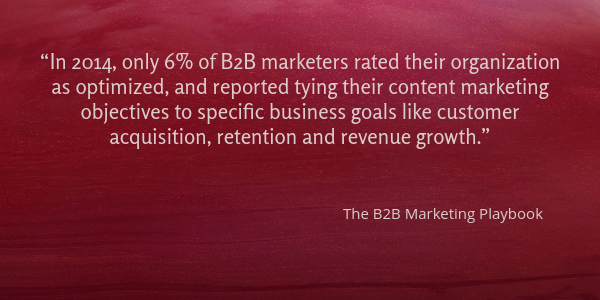It’s not easy to know where and how to allocate funds to craft an effective content strategy. Between technology, resources, and implementing specific tactics, cobbling together a winning marketing mix can feel a bit like playing chess in the dark.
Many companies continue to rely on guesswork guided by the latest trends or past successes.
Yet, many B2B organizations continue to operate in chaos despite overall industry progress in both marketing technology and tools.
Why?
One crucial step is still missing: a clearly aligned content strategy. Many companies continue to rely on guesswork guided by the latest trends or past successes. Rather than concentrating on building a grounded marketing campaign platform tied to specific content marketing goals, they focus on tactics that have no specific plan or purpose.
Related: The Ultimate Playbook for Your B2B Marketing Strategy
To build a better, more direct path to customer connections and financial competency, make things easier at the source. Define a strategy before creating tactics to connect the dots between effort and ROI—build an effective content strategy first.
“In 2014, only 6% of B2B marketers rated their organization as optimized, and reported tying their content marketing objectives to specific business goals like customer acquisition, retention and revenue growth.”—B2B Marketing Playbook

Success Is in the Details: Where to Start With Strategy
When you anchor marketing efforts to a strong foundation, it’s easier to align teams and resources and measure results. To get a campaign started on the right foot always do the same thing first:
Align the budget with content goals.
Knowing what game pieces are on the table makes it a lot easier to find a way to use them effectively and track how they’re performing.
1. Establish Clear Goals and Tie Them to Objectives
Building a budget around clear marketing objectives makes ROI trackable from the get-go and provides a clear focus. Outlining a specific goal with distinct language makes it easier to map the ideation process and demonstrate specific paths and resources needed to reach a content goal.
An example of a goal tied to an objective might look like this:
Goal: To increase outreach to first-time customers by 25%.
Then, create specific objectives to help with that content goal.
- Establish a thank you/outreach program using team leads
- Create a clear workflow and set of questions around customer outreach
- Publish at least 2 customer success stories of 350 words each by end of the quarter
Once content goals are broken down into single ideas and connected with objectives, it’s easier to think on a “meta” scale. Team members clearly see the need for new tools, systems, and labor or establish ways to call on current resources to get things done. This approach to content goal setting also offers an opportunity for teams to nail down workflow requirements or pinpoint needs for related marketing content.
One additional part of goal planning is knowing the reach of the organization’s current technology capabilities. As the biggest expense and marketing tool, technology influences every inch of effective content strategy execution internally and externally.
To craft an integrated marketing strategy, clearly lay out the marketing stack (tools, technology, and resources). Then map how it will help specifically meet and measure the outlined content goals. This makes collaboration easier and clarifies what data is being measured and tracked consistently for the company as a whole.
Related: 8 Simple Marketing Templates for Planning Content Strategy [FREE Download]

2. Define the Buyer’s Journey and Pair It with Relevant Content
Establishing the best, most effective buyer experience requires using a one-company mindset to build it.
To keep things cross-functional and consistent, appoint a marketing ideation committee comprised of key content stakeholders from within and outside the marketing team. Have teams work together on common goals and content requirements, including how to define key content terms and “buyer phases.”
Clarify pain points and what’s needed to educate customers at every stage of the buyer’s journey.
When customers can’t get the information they need at key touchpoints or feel challenges are not being addressed, they move on. Don’t give them a reason to leave. Clarify pain points and what’s needed to educate customers at every stage of the buyer’s journey.
Then, outline content types to the specific stages to meet content goals. Focus on content types (press release, blog post etc.) for each stage, rather than one specific content piece.
When everyone in the organization has a stake in the buyer’s journey it improves communication internally and externally, moves leads from one stage to the next with more ease, aligns tracking and reporting and helps to define a more effective content strategy.
3. Understand Your Customer Personas
Personas for B2B organizations are more than a sales tool, they serve as your best friend when crafting a buyer’s journey. Why? Within B2B organizations there is no “one” person to influence but a string of people, and each one has different needs, goals, and concerns to address.
Related: How Personas Keep B2B Marketers from Playing Guess Who with Content
To build a clearer picture of the specific, targeted personas for your market, get creative. Build customer personas based on the type of user as well as what specific things a product or service has to offer them.
Use insights collected to dig deep into the details.
Conduct internal interviews to get insight from sales reps, customer service reps, and other departments. Also, add in any relevant customer feedback. The more you engage with the people you are selling to, the more specific you can be in crafting accurate personas to help shape an effective content strategy and fine-tune the content created.
Use insights collected to dig deep into the details. Then, build a clear narrative around how a specific target audience consumes information or the types of success stories that will trigger a positive reaction for them.
This systematic approach to marketing strategy enables organizations to stay in alignment with what clients need and want most while building a marketing content story around how to serve all of the customers in the purchase process.
Starting off with these three key steps helps shape a solid foundation for a clear, effective content strategy to use again and again for each marketing campaign. Leveraging this approach also fosters a more organized internal workflow that translates into fewer headaches and improved ROI.

